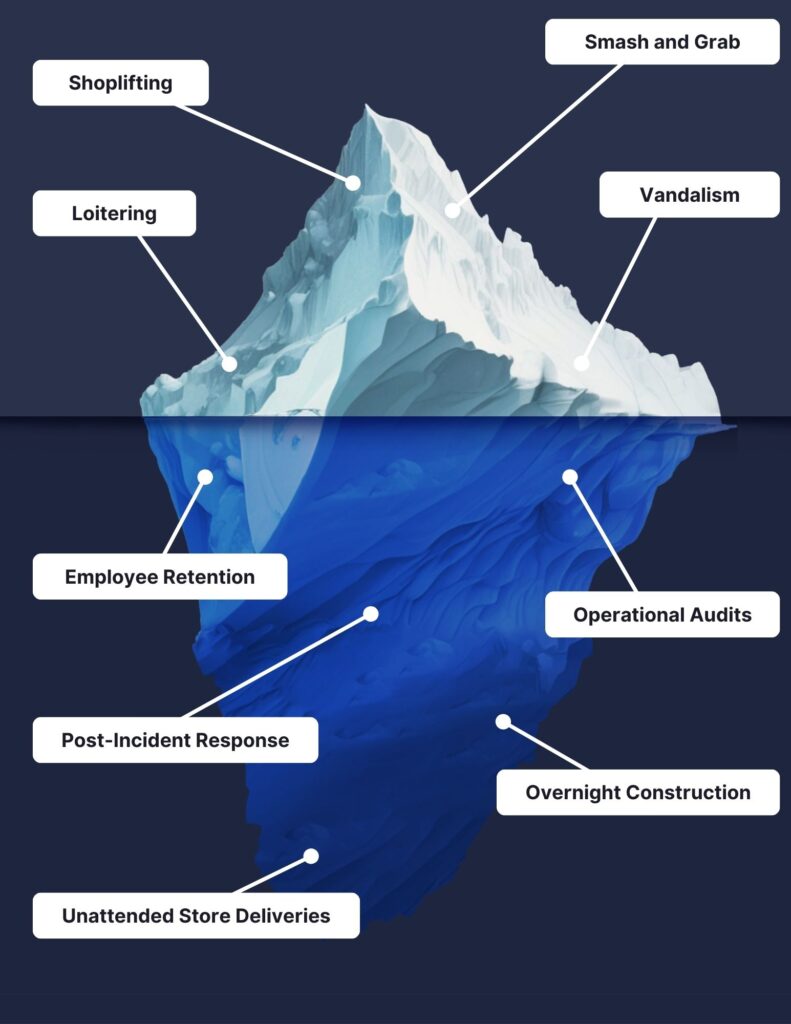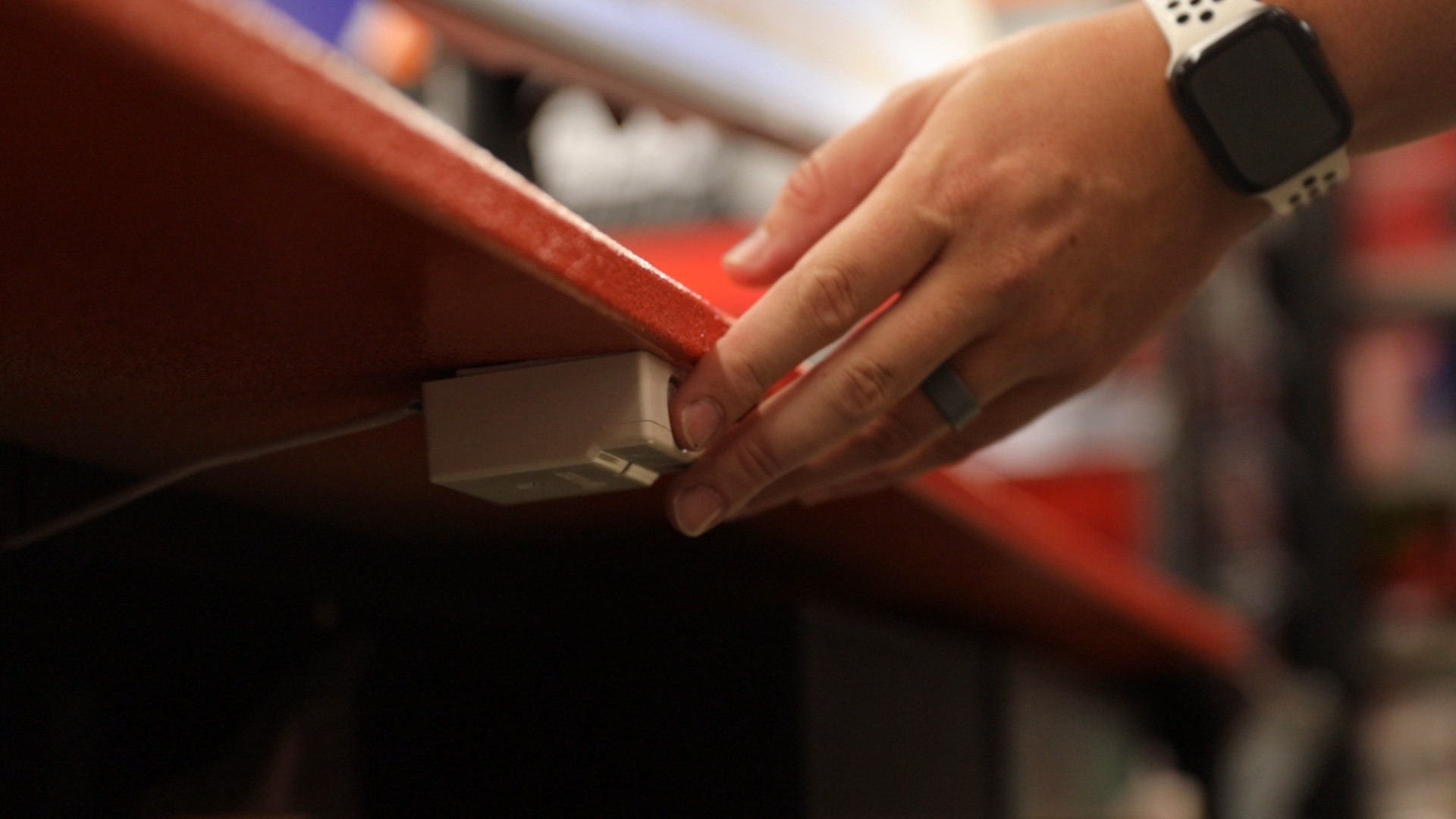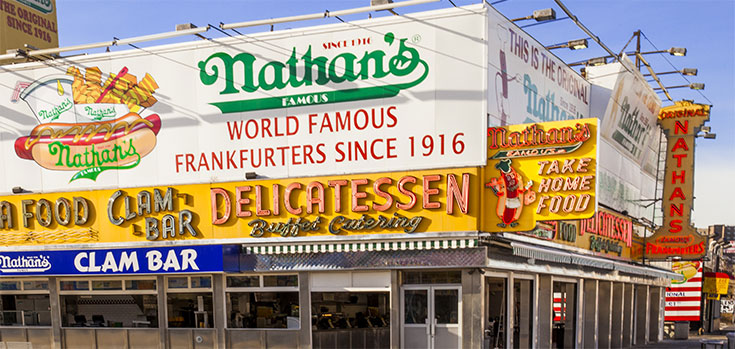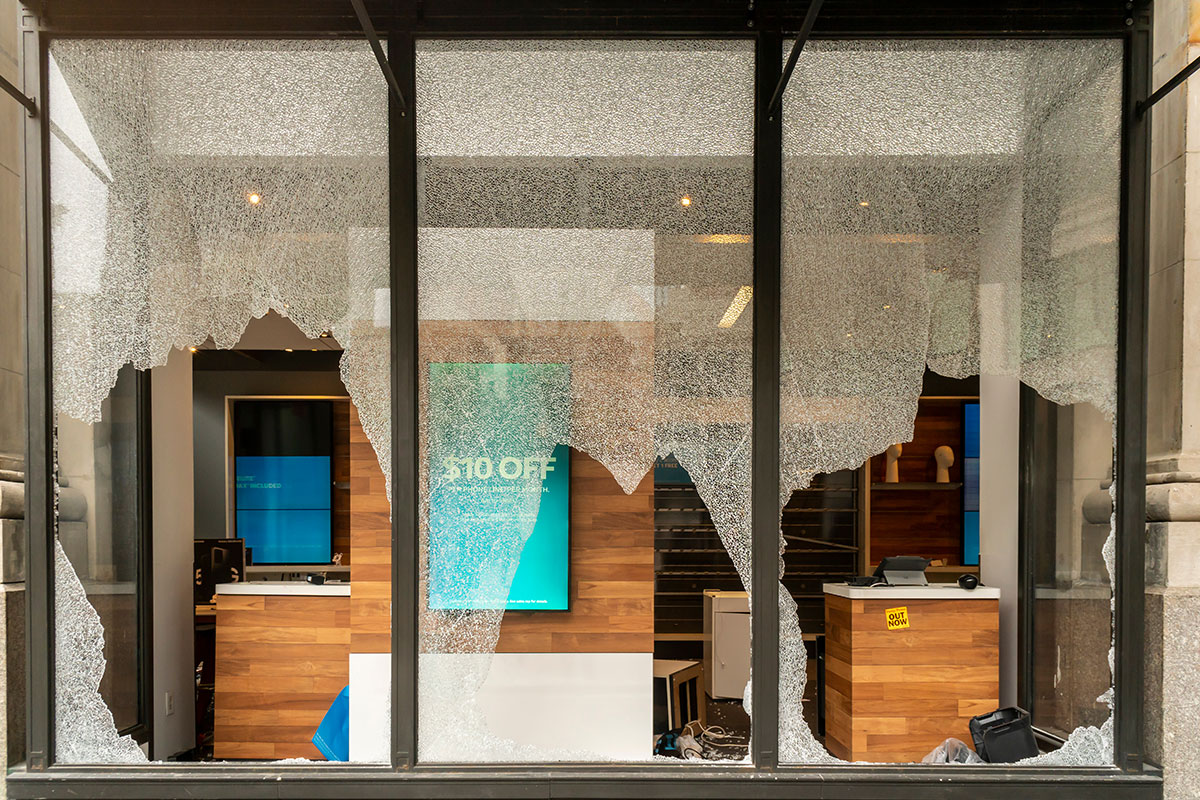Video monitoring has become the first line of defense for asset protection and loss prevention teams at retail and restaurant chains. Use cases for video monitoring are already well understood and they cover the most common threats – burglary, robbery, shoplifting, vandalism, and internal theft.
However, what is not understood is to what extent video monitoring addresses these risks and what else can be accomplished by video monitoring in the context of current technology innovations.

This blog post offers loss prevention and asset protection teams insights on how a combination of advanced video monitoring technology along with a well-trained monitoring team can not only deliver a wide range of business security services but also offer advanced operational insights, and improve employee morale.
1. Stop Shoplifting
However, if video monitoring by a remote monitoring team is enhanced with the ability to issue voice-down commands, shoplifters can be stopped in their tracks even before they commit shoplifting and, in many cases, force them to rethink their choices even after they pocket the merchandise.
- Shoplifting is a crime of opportunity and it ends the moment the shoplifter realizes someone is watching them. The overt security presence in the form of a voice-down commend either recorded or live has a significantly better impact on shoplifters who are accustomed to video surveillance.
- When live video monitoring can be requested on-demand by a store employee who has direct access to a remote command center via a security phone, suspicious actions by anyone at the store can be spotted and acted upon. Remote security staff can then deliver targeted voice-downs that can sometimes describe the person committing a crime or issue a general command about the security presence.
- Remote video monitoring and voice-downs can also be timed to align with key moments of the day when shoplifting spikes. For example, convenience stores near schools see a spike in security incidents when the school ends for the day in the afternoon. That’s when “gangs” of teens walk into a store and start pocketing merchandise.
- Shoplifters are no longer deterred by passive surveillance.
- Live 24/7 video monitoring may still require action on the ground when a shoplifter is caught in the act.
- Involving employees in confronting or stopping shoplifters is risky and often not encouraged by the store operators.
- The presence of security guards increases the risk of confrontation, life threat, and liability claims exposure.
- Periodic virtual tours with live voice-down commands can demonstrate “active” security presence and deter shoplifters.
- Using security phones or concealed panic buttons, employees at the store can request live monitoring and voice-down anytime they see suspicious activity.
2. Deter Smash and Grab
Smash-and-grab incidents have become a serious threat for many retailers and even restaurants. Some of the worst affected states like California have increased spending on law enforcement to combat smash-and-grab incidents in the state that’s forcing retailers and restaurant chains to close down operations in high-risk areas.
In situations where smash and grab is already in progress, the standard operating procedure at most retailers is for employees to back off and not confront the criminals. If a security guard is present on site, the situation can become more challenging as the guard may be targeted by the gang as they seek to subdue any potential threat to their plan.
Remote video monitoring with interactive capabilities can make a difference in minimizing losses and providing a greater chance for law enforcement to apprehend smash-and-grab perpetrators.
- Remote surveillance with periodic voice-downs announces active security presence to those casing a location. With interactive monitoring, employees can request active monitoring using the security phone if they suspect anyone at the store acting suspiciously such as asking where the most expensive items are kept.
- When remote monitoring is combined with live voice-downs, criminals know they are under surveillance and law enforcement is probably on their way. This can help minimize damage and loss as the perpetrators look to leave the premises quickly.
- Remote video monitoring enables faster information dissemination to internal loss prevention teams, mall security, and law enforcement. This can be valuable in securing nearby locations proactively or improving the chances of apprehending criminals.
- Gangs operate with impunity as SOPs in most consumer-facing establishments focus on employees stepping aside and directing customers away from gangs.
- There is no way to stop gangs from casing the location.
- The presence of security guards increases the risk of confrontation, life threat, and liability claims exposure.
- Real-time information about gangs is usually not available for law enforcement or mall security to take action.
- Alert the central station to seek active surveillance assistance or initiate voice-downs based on the situation that’s unfolding while staying away from harm’s way.
- Deter casing with frequent remote virtual tours accompanied by voice-downs.
- Gain complete situational awareness and pass on valuable information to security teams and law enforcement.
3. Prevent Vandalism and Loitering
Retail and restaurant chains across the US are battling incidents of smash-and-grab, break-ins, and vandalism. Brands with downtown locations are facing additional headwinds in the form of fewer footfalls, homelessness, vandalism, and vagrancy. With retailers cutting back on hiring, more retail employees are working alone in high-risk situations.
While retailers and restaurant brands have complete control inside the four walls of their stores, they have little or no control over what happens outside and in the perimeter. In downtown locations abetting back alleys, potential troublemakers can find hidden spots to congregate or engage in nefarious activities.
While remote video monitoring can offer 24/7 surveillance inside and outside the store, its effectiveness can improve exponentially with AI-enabled cameras that can accurately detect people or vehicles. Automated detection of unauthorized presence of vehicles or people can be augmented by automated voice-downs, strobes, and lights to ensure prompt action is taken to mitigate risks.
Virtual Perimeter Guard that plays out pre-recorded messages when the AI camera flags a security threat can deliver a wide range of security outcomes:
- Detects threats autonomously and plays appropriate pre-recorded messages, optional strobes, and/or lights.
- Customizable for diverse use cases - after-hour drop-offs, loitering, vagrancy or illegal encampments, vandalism, and unauthorized parking.
- Plays a sequence of follow-up messages based on the subject’s compliance with warning messages. Helps in shortening any undesirable activity before it causes major damage.
- Handles non-security tasks too - welcome greetings for customers during business hours or remind employees about operating procedures.
- Can be integrated with the command center for live video monitoring and voice-downs and give store employees the means to contact the command center for real-time monitoring or voice-down.
- Monitoring the entire perimeter of a store or restaurant for potential security threats such as loitering, vandalism, and casing is not always foolproof as it requires either a security guard on-site to make frequent rounds or have remote monitoring teams review live video feeds at all times.
- Human monitoring for large perimeters (both onsite and offsite) is prone to errors and lapses.
- Employees may end up confronting loiterers or vandals. This might escalate the situation or put them in harm’s way.
- Offer continuous and proactive security presence with AI-enabled video monitoring augmented with voice-downs and lights.
- Trigger voice-downs to announce security presence based on automated threat detection or alarm events such as glass-break alarms.
- Deploy 360-degree, always-on monitoring with no gaps.
- Eliminate the need for employees to directly interact with troublemakers.
- Benefit from versatile applications that go beyond securing the premises.
Find out how Interface uses AI-enabled cameras to deliver autonomous video monitoring that stops crime before it happens.
4. Enhance Post-Incident Response
Consumer-facing businesses with retail locations bear the brunt of social or civil unrest. Way back in 2020, when the country was swept by widespread social unrest, thousands of store locations were looted or vandalized.
While there are several ways to proactively deal with the safety and security of people and merchandise in the event of social unrest, how can retailers, restaurants, and other consumer-facing businesses deal with the aftermath of unrest? The same question applies to more frequently occurring incidents such as robberies, floods, or smash-and-grab attacks.
“While we cannot always control what happens outside of our stores and facilities, we can shape the culture within”, remarked the then-CEO of Macy’s speaking about the 2020 race riots.
At a time when employees are on the edge and customers are apprehensive about visiting stores that are recovering from recent attacks, video surveillance coupled with interactive monitoring capabilities such as voice-downs, can mitigate anxiety among employees and customers.
For example, remote business security service providers like Interface help customers address this issue by adopting the following protocols:
- Ramp up the frequency of remote virtual walkthroughs.
- Increase the frequency of live voice-down announcements at the store.
- Enable opening and closing security escort services for employees.
Demonstrating live security presence 24/7 using a combination of video and interactive monitoring greatly improves the work environment and customer experience, especially in the aftermath of violent incidents.
- Employee anxiety about safety at the location.
- Higher perceived risks when opening or closing the store.
- Diminish customer footfall and reduce time spent at the store.
- Demonstrate security presence by increasing the frequency of virtual walkthroughs and conducting live voice-downs to reassure employees and customers.
- Act as eyes and ears for employees opening the store or closing the location.
5. Boost Employee Retention
A recent survey conducted by Motorola found that 2 out of 3 retail workers had expressed concerns about their safety at work. In another survey by Verkada that included all consumer-facing businesses, 50% of those surveyed declared they were considering leaving the employer if they did not improve safety.
At a time when retail and restaurant businesses are already reeling from high employee turnover, increasing incidents of crime and violence at the workplace only make this problem acute. Boosting safety by deploying security guards is expensive, unreliable, and often negatively impacts the perceived safety as new customers may see guards as a sign of trouble.
Remote video monitoring with interactive capabilities can address these challenges.
- Remote video monitoring augmented with periodic voice-downs reassures employees and customers about a constant security presence.
- Offering employees multiple options to immediately seek attention overtly or discreetly (such as using security phones and hidden panic buttons) greatly alleviates security concerns.
- Interactive video monitoring services like on-demand security escorts during store opening, closing, or trash runs add to the sense of safety among employees who may be operating alone.
Employees feel safer when they can interact with a live security professional on demand or notice that someone is proactively checking in on them. It’s a “warm safety blanket” that boosts morale and improves employee retention.
- Increasing incidents of disruptive customers, vandalism, vagrancy, and violent crimes force frontline employees to quit.
- Employees fear for their safety when working alone during night shifts when there is no one available to seek help.
- Offer continuous and proactive security presence with remote video monitoring.
- Augment video monitoring with periodic voice-downs or on-demand voice-downs to announce security presence.
- Give employees the option to virtually summon security presence for carrying out high-risk tasks.
6. Monitor Overnight Construction or Renovation
Retailers and even restaurant chains understand the importance of customer experience in bringing back customers and increasing the basket size. For example, Walmart spent about $9 billion in the last two years to renovate over 1400 stores. Restaurants too are revamping their locations with expanded drive-thrus and streamlined dining areas.
The bottom line is that consumer-facing multi-site businesses will have to deal with periodic overnight construction activity at some of their locations. Securing the locations when you have a third-party construction crew on the premises is a tricky challenge especially when you have valuable merchandise, equipment, or inventory at the same location.
Just deploying a security guard to watch the construction crew is expensive and has several drawbacks. Security guards may not be able to maintain vigil and ensure compliance all the time, they may show up late or need to schedule their breaks properly.
If remote video monitoring capabilities are already available at locations where overnight construction is scheduled, it throws open a variety of options for the business to monitor if the construction crew is compliant and everything in the location remains intact.
With remote video monitoring and interactive monitoring capabilities, businesses can:
- Schedule temporary remote virtual tours when the crew is working on-site to ensure the crew is not violating any policy (leaning against a display unit, not covering up their boots, to name a few).
- Make available interactive monitoring capabilities for the construction crews to check in on a need basis such as when leaving the site for a break or coming back in.
- Check if all the entry and exit points are secured at all times.
- Deliver live voice-downs on a need basis to ensure compliance.
- Record videos of compliance and policy violations to create an audit report for the business which can also be shared with the construction company to ensure better compliance and safety at the location.
Remote video monitoring allows multi-site businesses to track and monitor construction safety at hundreds of locations at a time at a fraction of the cost of hiring security guards. In addition, the recorded video serves as a powerful audit and training tool for the construction crew and the loss prevention or asset protection teams.
- Need for deploying expensive security guards at every location.
- Last-minute guard replacement challenges or no-shows.
- No tangible value in terms of learning or best practices is possible.
- Replace security guards with an advanced solution at a fraction of the cost for the duration of the overnight construction project at any number of locations.
- Service is always available as per the construction schedule.
- Intervene in real-time with voice-downs to address safety issues or policy violations.
- Audit locations for compliance or policy violations by construction workers. Share audit reports with stakeholders for remediation.
7. Manage Unattended Direct Store Deliveries
Unattended Direct Store Deliveries (DSD) is a popular restocking model in several retail categories like grocery, beverages, and large restaurant chains. This delivery model involves a supplier or distributor to ship the products directly to the store every night for restocking the location.
The DSD model is cost-effective for the business provided it’s managed properly. Because deliveries are unattended and made by third-party drivers when the restaurant or store is closed or running with a skeletal staff, there is an increased risk of theft, liability claims, or accidents.
A video monitoring solution that’s integrated with access control and intrusion alarms at the location can address these risks comprehensively.
- Assign specified time slots for 3rd-party drivers to access the backdoors for restocking.
- Track all instances of backdoor opening and closing and record video evidence every time the door is opened.
- Track exceptions such as door open outside scheduled delivery slots, open doors, and movement of delivery personnel outside designated areas.
- Minimize fraudulent liability claims by 3rd-party drivers.
- Minimize the need for expensive security guards.
- Completely reliant on 3rd-party drivers to ensure every delivery is done as per the rules and policies governing unattended deliveries.
- Absence of irrefutable evidence in case of injuries, theft, property damage, or inventory damage.
- Enforce access to the facility only at predefined time slots and capture evidence of compliance by integrating video monitoring with access and alarm systems.
- Record exceptions and use video evidence for training, claim management, or process improvement.
8. Audit Business Operations
Monitoring store or restaurant operations is a complex challenge for brands, especially for those with numerous locations and diverse formats. To ensure compliance with corporate standards and brand guidelines, retailers and restaurant chains deploy on-site auditors who may conduct planned or even unscheduled audits at different locations.
Onsite audits, while being effective, have inherent limitations. It’s expensive to deploy auditors on-site when there are thousands of locations to manage. The auditors can’t observe what’s happening while remaining discreet in areas where customers are out of bounds.
Video monitoring can address these issues. Because almost all parts of the store or restaurant are under video surveillance for security purposes, it makes a lot of sense to start auditing the location by observing the security footage.
Some of the areas that can be easily audited using video monitoring include:
- Safety and Security: Store opening or closing procedures, delivery management, bank runs, cash movement.
- Customer Experience: Employee uniform compliance, clearing shopping carts, clearing spillages and debris, cleaning tables and surfaces.
- Merchandising: Stock-outs, display guidelines, promotions compliance.
- Staffing: Queue lengths, dwell times, staff on the floor.
Did you know? Interface offers advanced business analytics solutions (including remote audits) for retail and restaurant chains. Find out how your security cameras can do a lot more than what you thought was possible.
- Site audits are expensive.
- On-site auditors may not be able to perform discreet audits at all times.
- It is difficult to deploy auditors at all locations.
- Site audits can be disrupted due to external factors such as poor weather, transport disruptions, or pandemics.
- Leverage existing security camera infrastructure and minimize the need to deploy on-site auditors to dramatically reduce costs.
- Conduct discreet audits at scale for any number of locations or schedule audits based on operational cadence.
- Audit any location at any time of the day or week and under any circumstance.
- Capture screenshots screenshots from the video recording or live video to go with the audit reports.
- Extend the use of security cameras beyond the core security use cases to accelerate ROI from any camera hardware upgrade that may be needed.
Schedule a free business security consultation to find out how Interface can help you discover what loss prevention teams have always been missing.



